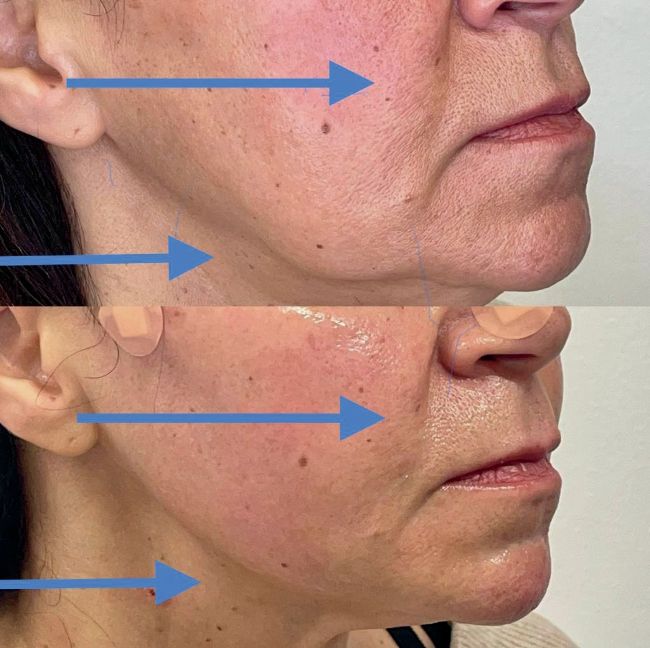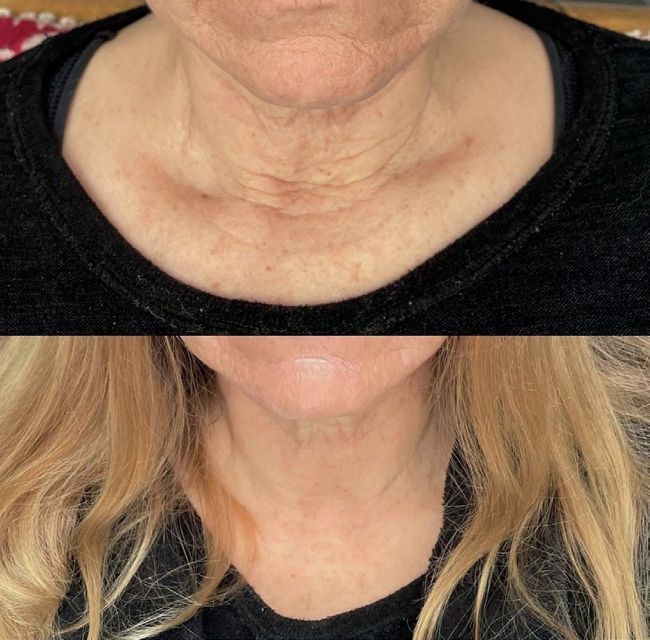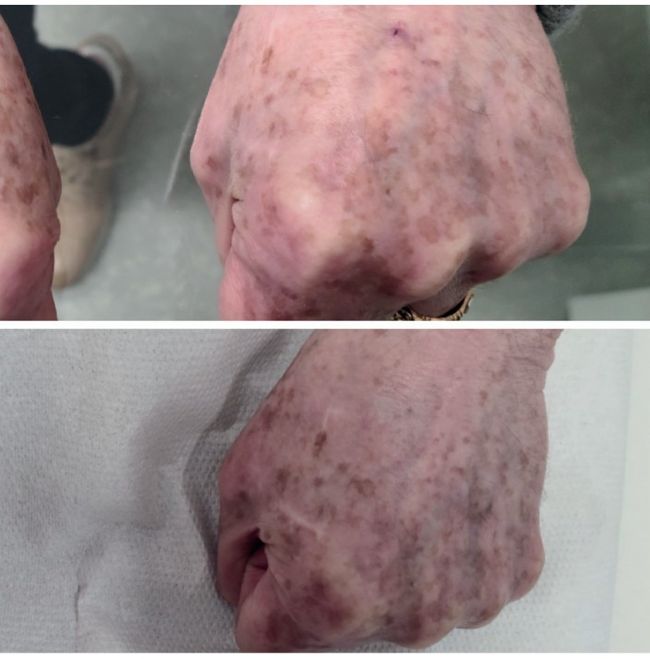CASE STUDY
Combined treatment in aesthetic medicine using mechanical stimulation for facial rejuvenation
Evaluating the efficacy of incorporating mechanical cell stimulation into facial treatments
DR PHILIPPE HAMIDA-PISAL
Dr Philippe Hamida-Pisal is currently the president of The Society of Mesotherapy of the United Kingdom (SoMUK) and the co-director of the Society of Mesotherapy of South Africa (SoMZA). He is an aesthetic practitioner specialising in dermatology and the founder and managing director of PHP Aesthetic and PHP Wellness, divisions of PHP Health First. Dr Hamida-Pisal also works as a skin consultant and adviser for model agencies in London and Paris. PHP offers the only French Touch 360° holistic approach, combining aesthetic, holistic and anti-ageing nutrition.
Demand for non-surgical aesthetic procedures for ageing well is experiencing unprecedented interest at the moment.1-4 As techniques have become more complex, non-surgical procedures provide a ‘look’ akin to that of an actual surgery with drastically reduced treatment and recovery times.5-7 People are integrating cosmetic procedures, both surgical and non-surgical, into their personal care routines, and treating these procedures with the same caution as you might approach a haircut or visit to the dentist.8-11 The International Society of Aesthetic Plastic Surgery (ISAPS) produced a global report on aesthetic and cosmetic procedures performed in 2022, which revealed that a total of 33,844,293 procedures were carried out globally in 2022, compared with around 23,266,374 in 2018 and 20,236,901 in 2014, and there was a 57.8% increase in cosmetic procedures over the last four-years.11-13 The report also revealed that, between 2021-2022, there was a 7.2% increase in the popularity of non-surgical procedures and a 16.7% in surgical procedures.
In this study, we chose to investigate the synergistic efficacy of mechanical cell stimulation. These will help recreate the ideal environment for fibroblasts, leading to an increase in collagen and elastin production for the restructuring of mature skin and preventing future ageing signs.5-7,12,14-15
MATERIAL AND METHODS
Thirty male and female patients from 30 to 75 years old participated in a combined aesthetic treatment with mechanical cell stimulation using LPG Endermologie. The median age was 45 years. All the patients were healthy, with no previous history of surgical or non-surgical procedures to improve skin quality on the face in the last 12 months. The study was conducted over a period of three weeks. All patients underwent a combined aesthetic treatment. The evaluator conducted a complete assessment of each patient:
I. Prepare the cutaneous and subcutaneous tissue to restore cellular activity.5-7
II. Combine to treat the indications.14-15
III. Maintain to increase patient loyalty and satisfaction. IV. Repair to treat potential side effects.16-19
PROTOCOLS
• Prepare to stimulate microcirculation, mobilise interstitial fluids and soften the tissues by using mechanical cell stimulation one week prior to the procedure.
• Combine the aesthetic procedure for:
Face: Loss of oval, widening of facial curves, changes in skin quality (wrinkles, fine lines, spots, rosacea).8,20-22
Body: For cellulite, localised ad resistant fat and sagging skin.17,23,24
• Use LPG Endermologie the same day and prior to the procedure for eight minutes.
• Maintain to mobilise fluids, relieve pain, promote natural lipolysis, stimulate collagen and elastin production. LPG Endermologie is used from three to 14 days post procedure depending on the aesthetic treatment.
• Repair to treat possible side effects, such as hematoma, oedema, fibrosis, scars.
RESULTS

Prepare: week -1: two LPG sessions Combine: day of the procedure: one session eight minutes Week 1-2-3-4-5: one LPG session

Indications: oval of the face, skin laxity Prepare: week -1. two LPG sessions Combine: day of the procedre: one session eight minutes Week 1-2-3-4-5: one LPG session

Prepare: week -1: one LPG sessions Combine: day of the procedure: None Week 1-2-3-4-5: one LPG session
DISCUSSION
Several studies have demonstrated the effect of mechanical cell stimulation treatments on fibroblasts.
As early as 1998, in Nashville, Tennessee, researchers from Vanderbilt University tested mechanical cell stimulation treatments on an animal model: Yucatan mini-pigs. The histological examination – after biopsy of the treated subcutaneous tissues – showed significant changes in the architecture of those tissues with the appearance of dense and horizontal bands of endogenous collagen in a dose-dependent manner. The collagen content varied from 27% to 130% depending on the number of sessions (10 or 20 sessions).8,22,24 Those results demonstrated for the first time the effective stimulation of fibroblasts by mechanical cell stimulation treatments and were the subject of two scientific publications.
In 2002, results observed on collagen in the animal model were confirmed for humans in a study conducted by the Dermexpert laboratories in Paris. Results clearly show the links between mechanical stimuli and the production of collagen but also of elastic fibres by fibroblasts. Their densification observed in histology shows a firming of the skin and corroborates the clinical dermatological examination – improvement of skin quality, and reduction of signs of facial skin ageing.
In 2003, an Italian team from La Sapienza University in Rome, carried out a histological study after eight weeks of treatment. Analysis of skin samples from the treated side showed different changes compared to untreated control skin samples and in particular an increase in the number of fibroblast nuclei (+37.5% on average) and remodelling of dermis and epidermis. Results show that mechanical stimuli can cause morphological and probably functional changes in skin tissue. Authors interpreted those results as a process of fibroblast activation that proliferates and acquires a secretory state under the effect of mechanical stimuli.8,18,22,24 In 2015, Professor Humbert’s team at the Study and Research Centre on Tegument of Besançon, France, compared the behaviour of stimulated (Endermologie) and unstimulated (control) fibroblasts stemming from skin biopsies on the face.
Results show the intimate effects of the stimulation treatment at the heart of the dermis: stimulation of the production of collagen, elastin and hyaluronic acid (+80%), remodelling of the dermis, improvement of signs of skin ageing (firmness, luminosity, wrinkles).12 Overal,l all studies showing the effectiveness of mechanical cell stimulation combined with aesthetic treatment highlight a holistic approach for the patient for an optimum result with less downtime and better satisfaction.25 Using this approach proves to be more effective towards skin quality, skin tonicity, firmness, hydration, radiance, less wrinkles and fine lines.12,13
CONFLICTS OF INTEREST
Ambassador for Fillmed Laboratory, LPG Laboratory and MINT PDO Threads.
STATEMENT OF ETHICS
All procedures adopted in the present study were in respect to the ethical standards in the World Medical Association Declaration of Helsinki.
Written informed consent was obtained from the patients for publication of this case report and any accompanying images. This retrospective review of patient data did not require ethical approval in accordance with local/national guidelines.
AUTHOR CONTRIBUTIONS
Dr Philippe Hamida-Pisal conceived the presented idea, carried out the procedures and wrote the manuscript. Hamida-Pisal P. combined treatment in aesthetic medicine using LPG endermologie for facial rejuvenation: a case series. J Dermat Cosmetol. 2023;7(3):99102. DOI: 10.15406/jdc.2023.07.00244
REFERENCES
1. Fanian F, Humbert P. Facial skin ageing: a new treatment option through Endermolift process. XI International Congress on Aesthetic and anti- aging Medicine; Sept 30-oct 2; Varsow. 2011.
2. Majani U, Majani A. Mechano-stimulation and minimally invasive surgical techniques of the face and neck. 15th International congress of Aesthetic Medicine; Oct 18-20; Milan. 2012.
3. Monteux C, Castaing C. Mechano-stimulation: Scientific overview and addedvalue in aesthetic medicine. 11th Annual Convention of Philippine Academy of Dermatologic Surgery Foundation Inc (PADSFI). February 22-24; Mandaluyong City, Philippines. 2013.
4. Haftek M, Jeudy A, Colomb E, et al. Ultrastructural changes induced by mechanical stimulation of the aged skin. SCUR 2013- 40th Annual Meeting & 6th Joint Meeting with SSSR; May 12–14; SALZBURG, Austria. 2013.
5. Watson J, Bela Fodor P, Cutcliffe B, et al. Physiological effects of endermologie®:A preliminary report. Aesthetic Surgery Journal. 1999;9(1):27–33.
6. Stimulation of the fibroblasts: Dr Adcock, Venderbilt. University USA. Aesthetic Surgery Journal. 1998.
7. Stimulation of the fibroblasts: Pr Revuz, Paris (Les Nouvelles Dermatologiques). 2002.
8. Innocenzi D, Balzani A, La Torre GMG, et al. Evidence des modifications cutanées induites par la Technique LPG® via une analyse d’images. Dermo Cosmetologia. 2003;1:9–15.
9. Revuz J, Adhoute H, Cesarini JP, et al. Clinical and histological effects of the Lift-6 device used on facial skin ageing. Nouv Dermatol. 2002;21:335–342.
10. Tenna S, Emiliozzi C, Scuderi S. Approach of the Lift-6 device in the treatment of décolleté. J Méd Esth et Chir Derm. 2003;30(117):53–57.
11. Majani A, Majani U. Mechano-stimulation in aesthetic medicine and minimally invasive surgical techniques of the face and neck. 15th International Congress of Aesthetic Medicine of AGORA AMIEST Italian Society of Aesthetic Medicine. October 10-12, Milan, Italy. 2013.
12. Humbert P, Fanian F, Lihoreau T, et al. Mécano-StimulationTM of the skin improves sagging score and induces beneficial functional modification of the fibroblasts: clinical, biological, and histological evaluations. Clin Interv Aging. 2015;10:387–403.
13. Kinney B. Non-surgical facial contouring, facial rejuvenation and post-surgery Use of the Lift-6 Device. XXIII Congresso Nazionale della Societa Italiana di Medicina Estetica; March 22-24; Roma. 2002.
14. Bourgeois JF, Gourgou S, Guillot B, et al. A randomized, prospective study using the LPG® technique in treating radiation-induced skin fibrosis: clinical and profilometric analysis. Skin Research and Technology. 2008;14(1):71–76.
15. Worret WI, Jessberger B. Effectiveness of LPG® treatment in morphea. Journal of European Academy of Dermatology and Venereology. 2004;18(5):527–530.
16. Improvement of lymphedema: Pr Piller, Adelaide, Australia, 2007. 17. Effectiveness on cellulite and remanent effect: Pr Ortonne, Nice, France (Les Nouvelles Dermatologiques). 2004.
18. Humbert P. Mecano-stimulation e ringiovanimento del volto: Studio randomizzato, semplice cieco con biopsie sul volto. 15th International Congress of Aesthetic Medicine of AGORA AMIEST Italian Society of Aesthetic Medicine. October 10-12; Milan Italy 2013.
19. Scuderi N, Fino P. Sinergia e vantaggi con la tecnica NEW ENDERMOLIFT e filler cross-linkati nella correzione delle rughe nasolabiali. Primi risultati e commenti nello studio prospettico, randomizzato in cieco e controllato. Congresso SIES Bologna. 2014.
20. Innocenzi D, Balzani A, Panetta C, et al. Modifications morphologiques de la peau induites par la Technique LPG. DERMOtime. 2002, anno XIV;7(8):25–27.
21. Breton-Torres I, Lefebvre C, Jammet P. Masso-kinésithérapie faciale postinjectionnelle en médecine esthétique. Kinésithérapie Scientifique. 2014;554:15–21.
22. Adcock D, Paulsen S, Davis S, et al. Analysis of the cutaneous and systemic effects of endermologie in the porcine model. Aesthetic Surg J. 1998;18(6):414– 422.
23. Improvement of cellulite. Journal of Cosmetic and Laser Therapy. 2013.
24. Adcock D, Paulsen S, Jabour K, et al. Analysis of the effects of deep mechanical massage in the porcine model. Plast Reconstr Surg. 2001;108(1):233–240.
25. Alberico FP. Endermologie + needling + LED: A winning combination in the treatment of skin aging. 13 International Congress of the Italian Society of Aesthetic Medicine (AGORA); October 13-15; Milano, Italy. 2011.